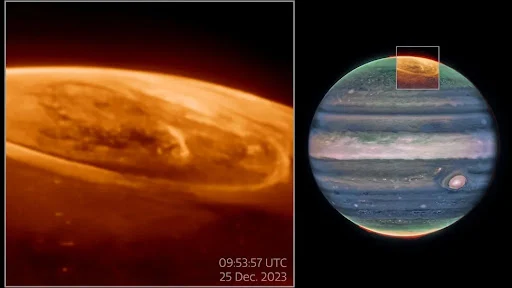The James Webb Space Telescope (JWST) has recently captured stunning new images detailing the bright auroras at Jupiter's north pole. These auroras are hundreds of times brighter and more energetic than those on Earth, exhibiting rapid and dynamic changes in brightness and structure, sometimes varying by the second.
Key Findings from the Observations:
- Exceptional Brightness and Energy: Jupiter's auroras are significantly more intense than Earth's, a phenomenon attributed to the planet's powerful magnetic field and the contribution of charged particles from its volcanic moon, Io, in addition to the solar wind.
- Rapid Variability: The JWST's observations, taken with the Near-Infrared Camera (NIRCam) on December 25, 2023, revealed that the auroral emissions from the trihydrogen ion (H3+) are far more variable than previously understood. Scientists expected changes over about fifteen minutes but instead saw the entire auroral region "fizzing and popping with light" on timescales of seconds.
- Unexplained Phenomena: Comparing the JWST's infrared data with simultaneous ultraviolet observations from the Hubble Space Telescope, scientists found that some of the brightest features seen by Webb had no corresponding features in the Hubble images. This suggests that very low-energy particles might be causing significant atmospheric excitation in a way that is not yet understood.
- Implications for Jupiter's Atmosphere: These observations will help scientists better understand how Jupiter's upper atmosphere is heated and cooled and the complex interactions within its magnetosphere.
What are Auroras?
Auroras, also known as the Northern Lights (Aurora Borealis) and Southern Lights (Aurora Australis) on Earth, are natural light displays in the sky, predominantly seen in the high-latitude regions (around the Arctic and Antarctic). They are caused by the interaction of charged particles, mainly electrons and protons, from the Sun with the atoms and molecules in a planet's upper atmosphere.
How Jupiter's Auroras Differ from Earth's:
- Source of Particles: While Earth's auroras are primarily driven by solar storms, Jupiter's auroras have an additional source: charged particles ejected from the volcanoes on its moon Io. These particles are caught by Jupiter's strong magnetic field.
- Scale and Intensity: Jupiter's auroras are much larger and hundreds of times more energetic than Earth's auroras due to its immense size and powerful magnetic field.
- Observed Wavelengths: The JWST's infrared capabilities allow for the observation of different wavelengths of light emitted by Jupiter's auroras, providing new insights compared to ultraviolet observations from Hubble.
These new images and data from the James Webb Space Telescope are crucial for unraveling the mysteries of Jupiter's auroras and its dynamic atmospheric environment. The findings will also support upcoming missions like the European Space Agency's Jupiter Icy Moons Explorer (JUICE), which will conduct detailed observations of Jupiter and its moons.


